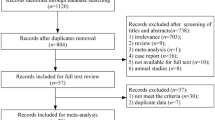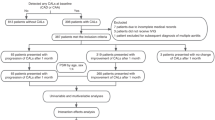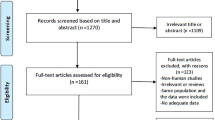Abstract
Background
Kawasaki disease (KD) has now become the leading cause of acquired heart disease among children in developed countries. This study investigated whether patients with KD have an increased risk of atherosclerosis.
Methods
Electronic databases, including PubMed, Embase and Springer link, were searched through June 1, 2015, for eligible studies. Studies were included when they met the following criteria: 1) an observational study focusing on evaluating the risk factors for atherosclerosis in patients with KD; 2) KD was diagnosed clinically according to the Japan Kawasaki Disease Research Committee or American Heart Association’s diagnostic criteria; 3) the study subjects were KD patients without coronary heart disease or related cardiovascular disease (KD group) and non-KD patients as control (control group), and 4) investigation of important atherosclerosis risk factors, total cholesterol (TC), low-density lipoprotein cholesterol (LDL), triglycerides (TG), systolic blood pressure (SBP), and flowmediated dilatation (FMD). The methodological quality of the included studies was evaluated using the Newcastle- Ottawa Scale. Mean difference (MD) and relative risk (RR) and corresponding 95% confidence intervals (CI) were used to calculate the pooled results.
Results
Sixteen studies were included with a total of 870 patients, including 421 KD patients and 449 non-KD controls. Differences in TG and SBP between KD patients and controls were not significant; in contrast, TC and LDL levels were significantly higher in KD patients than the controls, whereas FMD in the KD patients was significantly lower.
Conclusions
KD patients may have an increased risk of developing atherosclerosis.
Similar content being viewed by others
References
Kawasaki T. Acute febrile mucocutaneous syndrome with lymphoid involvement with specific desquamationof the fingers and toes in children. Arerugi 1967;16:178–222. [In Japanese]
Fukazawa R, Ikegam E, Watanabe M, Hajikano M, Kamisago M, Katsube Y, et al. Coronary artery aneurysm induced by Kawasaki disease in children show features typical senescence. Circ J 2007;71:709–715.
Suzuki A, Miyagawa-Tomita S, Komatsu K, Nakazawa M, Fukaya T, Baba K, et al. Immunohistochemical study of apparently intact coronary artery in a child after Kawasaki disease. Pediatr Int 2004;46:590–596.
Duan C, Du ZD, Wang Y, Jia LQ. Effect of pravastatin on endothelial dysfunction in children with medium to giant coronary aneurysms due to Kawasaki disease. World J Pediatr 2014;10:114–118.
The Newcastle-Ottawa Scale (NOS) for assessing the quality of nonrandomised studies in meta-analyses, 2011. www.ohri.ca/programs/clinical_epidemiology/oxford. asp (accessed August 3, 2014).
Higgins JP, Thompson SG, Deeks JJ, Altman DG. Measuring inconsistency in meta-analyses. BMJ 2003;327:557–560.
Simmonds MC, Higgins JP, Stewart LA, Tierney JF, Clarke MJ, Thompson SG. Meta-analysis of individual patient data from randomized trials: a review of methods used in practice. Clin Trials 2005;2:209–217.
Laurito M, Stazi A, Delogu AB, Milo M, Battipaglia I, Scalone G, et al. Endothelial and platelet function in children with previous Kawasaki disease. Angiology 2014;65:716–722.
Cho HJ, Yang SI, Kim KH, Kim JN, Kil HR. Cardiovascular risk factors of early atherosclerosis in school-aged children after Kawasaki disease. Korean J Pediatr 2014;57:217–221.
Ishikawa T, Iwashima S. Endothelial dysfunction in children within 5 years after onset of Kawasaki disease. J Pediatr 2013;163:1117–1121.
Noto N, Okada T, Karasawa K, Ayusawa M, Sumitomo N, Harada K, et al. Age-related acceleration of endothelial dysfunction and subclinical atherosclerosis in subjects with coronary artery lesions after Kawasaki disease. Pediatr Cardiol 2009;30:262–268.
Liu XQ, Huang GY, Liang XV, Ma XJ. Endothelial progenitor cells and arterial functions in the late convalescence period of Kawasaki disease. Acta Paediatr 2009;98:1355–1359.
Lee SJ, Ahn HM, You JH, Hong YM. Carotid intima-media thickness and pulse wave velocity after recovery from kawasaki disease. Korean Circ J 2009;39:264–269.
Gupta-Malhotra M, Gruber D, Abraham SS, Roman MJ, Zabriskie JB, Hudgins LC, et al. Atherosclerosis in survivors of Kawasaki disease. J Pediatr 2009;155:572–577.
Ghelani SJ, Singh S, Manojkumar R. Endothelial dysfunction in a cohort of North Indian children with Kawasaki disease without overt coronary artery involvement. J Cardiol 2009;53:226–231.
Niboshi A, Hamaoka K, Sakata K, Yamaguchi N. Endothelial dysfunction in adult patients with a history of Kawasaki disease. Eur J Pediatr 2008;167:189–196.
Borzutzky A, Gutiérrez M, Talesnik E, Godoy I, Kraus J, Hoyos R, et al. High sensitivity C-reactive protein and endothelial function in Chilean patients with history of Kawasaki disease. Clin Rheumatol 2008;27:845–850.
McCrindle BW, McIntyre S, Kim C, Lin T, Adeli K. Are patients after Kawasaki disease at increased risk for accelerated atherosclerosis? J Pediatr 2007;151:244–248, 248. e241.
Dalla Pozza R, Bechtold S, Urschel S, Kozlik-Feldmann R, Netz H. Subclinical atherosclerosis, but normal autonomic function after Kawasaki disease. J Pediatr 2007;151:239–243.
Cheung YF, Wong SJ, Ho MH. Relationship between carotid intima-media thickness and arterial stiffness in children after Kawasaki disease. Arch Dis Child 2007;92:43–47.
Cheung YF, Yung TC, Tam SC, Ho MH, Chau AK. Novel and traditional cardiovascular risk factors in children after Kawasaki disease: implications for premature atherosclerosis. J Am Coll Cardiol 2004;43:120–124.
Silva AA, Maeno Y, Hashmi A, Smallhorn JF, Silverman ED, McCrindle BW. Cardiovascular risk factors after Kawasaki disease: a case-control study. J Pediatr 2001;138:400–405.
Dhillon R, Clarkson P, Donald AE, Powe AJ, Nash M, Novelli V, et al. Endothelial dysfunction late after Kawasaki disease. Circulation 1996;94:2103–2106.
Krauss RM. Lipoprotein subfractions and cardiovascular disease risk. Curr Opin Lipidol 2010;21:305–311.
Toth PP, Grabner M, Punekar RS, Quimbo RA, Cziraky MJ, Jacobson TA. Cardiovascular risk in patients achieving low-density lipoprotein cholesterol and particle targets. Atherosclerosis 2014;235:585–591.
Catapano AL, Maggi FM, Tragni E. Low density lipoprotein oxidation, antioxidants, and atherosclerosis. Curr Opin Cardiol 2000;15:355–363.
Meydani M. Vitamin E and atherosclerosis: beyond prevention of LDL oxidation. J Nutr 2001;131:366S-368S.
Steinberg D, Parthasarathy S, Carew TE, Khoo JC, Witztum JL. Beyond cholesterol. Modifications of low-density lipoprotein that increase its atherogenicity. N Engl J Med 1989;320:915–924.
Chisolm GM, Steinberg D. The oxidative modification hypothesis of atherogenesis: an overview. Free Radic Biol Med 2000;28:1815–1826.
Celermajer DS, Sorensen KE, Gooch VM, Spiegelhalter DJ, Miller OI, Sullivan ID, et al. Non-invasive detection of endothelial dysfunction in children and adults at risk of atherosclerosis. Lancet 1992;340:1111–1115.
Doshi SN, Lewis MJ, Goodfellow J. Improving endothelial vasomotor function. BMJ 2001;323:352–353.
Drexel H, Amann FW, Beran J, Rentsch K, Candinas R, Muntwyler J, et al. Plasma triglycerides and three lipoprotein cholesterol fractions are independent predictors of the extent of coronary atherosclerosis. Circulation 1994;90:2230–2235.
Newman WP 3rd, Freedman DS, Voors AW, Gard PD, Srinivasan SR, Cresanta JL, et al. Relation of serum lipoprotein levels and systolic blood pressure to early atherosclerosis. The Bogalusa Heart Study. N Engl J Med 1986;314:138–144.
Author information
Authors and Affiliations
Corresponding author
Rights and permissions
About this article
Cite this article
Zhang, H., Xu, MG., Xie, LJ. et al. Meta-analysis of risk factors associated with atherosclerosis in patients with Kawasaki disease. World J Pediatr 12, 308–313 (2016). https://doi.org/10.1007/s12519-016-0023-0
Received:
Accepted:
Published:
Issue Date:
DOI: https://doi.org/10.1007/s12519-016-0023-0




